Black cats, jack-o-lanterns, spooky noises and folklore signify the fun fall festival of Hallowe’en.
If you use your imagination, nature has its own fall fun, depending on which side of the prickle you find yourself.
Let your imagination wander along a shadowy walk under a waning moon through a Rio Grande Valley thorn-scrub forest.
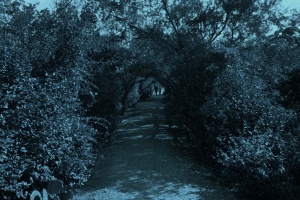
A few steps in on a narrow trail, a hundred tiny claws grab your bare arm and clothing, the needle-like prickles halting your progress. Probably not a band of witches’ cats, more likely a native shrub called Wright’s catclaw, Acacia wrightii.
Wright’s catclaw is a large shrub that’s friendlier in the daytime when you can see its recurved cat-claw-like armor on the twigs. Its friendlier elements are feathery leaflets, like other trees in the mimosa family, and aromatic flowers called catkins that push out after a rainfall.
Colima, Zanthoxylum fagara, by day is a lovely, small tree with unusual leaf groupings. When crushed, they smell of citrus. Not one to tangle with in the dark, it also is armed with re-curved prickles. In its gentler persona, colima is host to the giant swallowtail butterfly whose caterpillars eat the interestingly shaped leaves. When blooming, colima provides nectar for pollinators and food for birds when the berries ripen.
Granjeno, Celtis pallida, together with Wright’s catclaw and colima make a formidable, impenetrable security hedge that just might keep out ghouls and gremlins. Granjeno’s paired spines on zig-zag, snarling branches make it hard to release the human who has walked into it unawares.
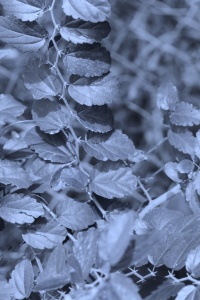
If you want to bring wildlife into your yard, though, granjeno is another wicked native whose branches provide shelter for critters and its fruit is consumed by birds and wildlife. It is a host plant to the American Snout butterfly.
With these native trees, if you do become entangled with a mass of their re-curved prickles, the best way to get released is to back out, opposite from the way you became ensnared. Carefully, of course.
Although seemingly rife with unfriendly vegetation, the Valley’s armed trees provide nesting sites for birds; leaves and twigs are browsed by deer and cattle; butterflies and other pollinators draw nectar when plants are in bloom; birds and other critters eat the fruits.
Want something creepier than flesh-ripping thorns? Look for the native shrub snake eyes, Phaulothamnus spinescens. The fruit, when ripe, will bring a wide-eyed stare if you’re not expecting to come across its translucent berries each of which contain one round black seed. Forget about pulling a couple off to take to show friends as thorns, although considered soft, make themselves known when you reach an arm into the shrub’s depth.
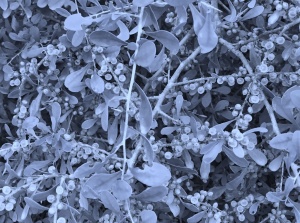
One more step into the darkness of the lane and the silky feel of a cat’s whiskers below your knee frightens a squeal from you. In the light of day, delicate pink stamens of cat’s whiskers, also called spider wisp, Cleome gynandra, reveals itself along the edge of the trail. Blooms turn into long, thin, dried-up-looking string beans, each containing about a dozen round seeds. Good food for quail.
Holding your breath near the trail’s end, you look toward safety when suddenly a great crackling and snorting is heard over the pounding of your heart. Before you can turn and run, a huge, black bulk on tiny legs emerges from the shadows. As it enters the clearing, you realize it’s only a javelina, not aggressive toward humans unless cornered. The omnivorous creature wanders back into the brush, in search of prickly pear cactus and ticks.
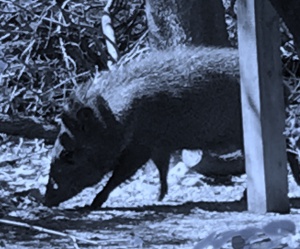
Ending your imaginative walk at dawn, common balloon vine, Cardiospermum halicacagum, seedpods glow luminescent orange in the rays of the rising sun like strings of tiny pumpkin lights, dangling under a roof line. One-inch-diameter globes grace thin stems interwoven through tree branches and low vegetation.
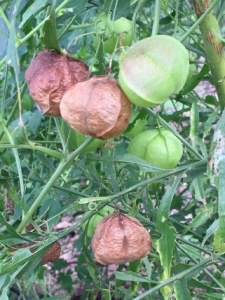
This plant is safe to gently examine. Spent pods burst open at the bottom, ejecting two to three black seeds. The vine is a host plant for the silver-banded hairstreak butterfly. Quail eat these seeds once they’ve fallen to the ground. Balloon vine can bloom throughout the year for a continual show as the pods turn from shades of green to brown as they mature.
What plants can you think of that would fit in with this wicked scary imaginary nature walk?
Look for these native specimens during one of our nature walks around Ebony Loop in Harlingen’s Hugh Ramsey Nature Park on first Fridays and odd Saturdays. The schedule is in the previous blog.

Leave a Reply